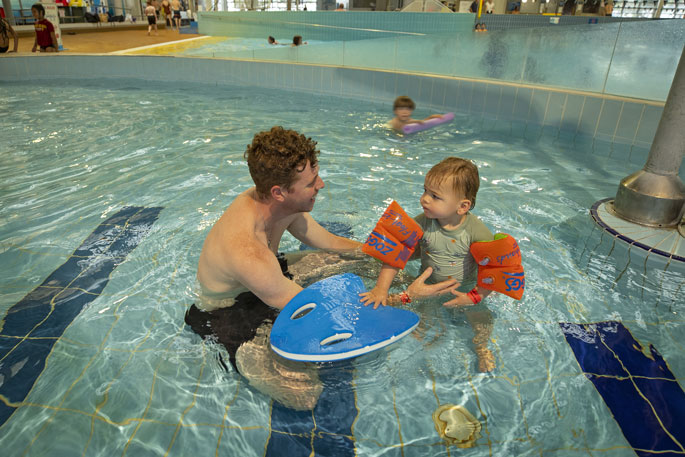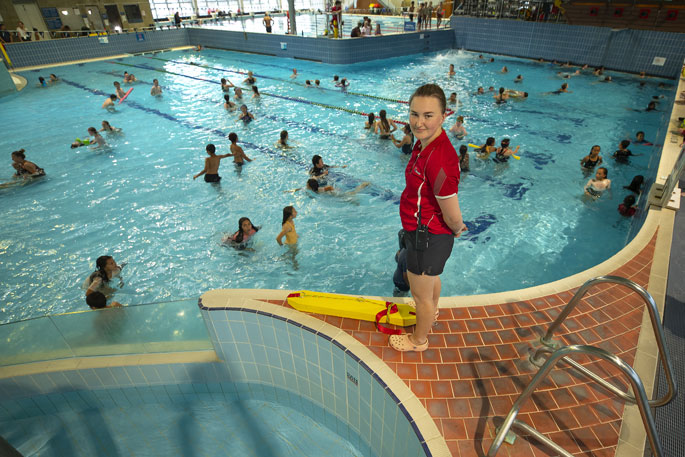Tauranga lifeguard Lauren McLellan was standing poolside earlier this year, scanning the busy Baywave crowd, when she spotted a small child attempting to jump towards a pool noodle in the deep end.
It was too late to intervene.
The kid jumped, couldn't make it to the floating noodle, and started sinking.
Lauren dived into the water fully-clothed – Crocs included – and pulled the crying child out of the pool. Their parent wasn't watching.
Bay Venues has had almost 50 wet rescues this year across its five aquatic facilities and more than 80 per cent of them have involved children aged between two and 10.
'Most of the incidents we respond to are the result of a child getting into trouble in the water while their parents aren't watching,” says Lauren.
Suddenly changes
'Sometimes the adult is actually in the pool, but they are distracted or aren't actively supervising their children.”
Child supervision is of course not a new issue when it comes to water safety.
In fact, Lauren has a vivid childhood memory of watching her mum – who is also a Bay Venues lifeguard – dive into a pool to save a kid while on holiday.
'Having now experienced that myself for the first time, I can see just how fast it all happens.
'One moment everyone is having fun and splashing, and then it suddenly changes. It legitimately takes a couple of seconds of inattention or distraction for something to happen. It certainly is an adrenaline rush but not the sort we want to experience.”
To try and tackle this issue, Bay Venues launched a new child supervision policy and campaign in 2020.
Keep Me Safe
Keep Me Safe is all about caregivers taking ownership of their child's safety in and around the water and new pool rules have been implemented to drive home the message and force change.
Caregivers must be 16 years or older and if they're looking after children who are aged five and under, they have to be in the pool with them and within arm's reach.
Both the children and their caregiver also have to be wearing red wristbands, which are issued on arrival. This helps lifeguards identify the youngest swimmers in the pool and their adult supervisors.
Children aged six to 10, meanwhile, have to wear yellow wristbands and their caregiver should also be actively supervising them.
This means the adult must be able to provide immediate assistance if required, they should be watching their child at all times – and they should be close enough to see, hear, and be heard by their child.
Keep Me Safe, which won a Recreation Aotearoa National Aquatic Innovation Award last year, also has parent-to-child ratios that have to be followed.
Still rescues
For example, with children aged five and under, it is one adult looking after no more than two children.
This new policy and campaign has led to a positive change, with a 36 per cent drop in the number of wet rescues across all venues in the first year. However it has not eliminated the issue altogether and it is still mainly children being rescued from the water.
 Kayle Lawson holds his son, Lucky, 18 months, while in the water at Baywave. Photo: John Borren/SunLive.
Kayle Lawson holds his son, Lucky, 18 months, while in the water at Baywave. Photo: John Borren/SunLive.
Bay Venues acting aquatic network manager Matthew Strange says there are situations where a parent is within arm's reach but does not recognise their child is drowning.
'It can be a silent process and look like they are playing. Trained and experienced lifeguards can see it and feel it in their gut within an instant but untrained caregivers can take a while to actually realise their child in front of them is in trouble.”
New campaign
Matthew says Bay Venues is about to run a new campaign around how to identify a child in distress in the water.
'Families visiting our centres have done a fantastic job of getting on board with being their child's personal lifeguard, but at times even caregivers doing a great job with supervision have looked straight at their child and not recognised they are in distress.
'It is our aim now to help all caregivers by providing some education around what drowning looks like, so that no matter what aquatic environment they are in, they can make the lifesaving judgement between someone having fun and playing, and someone in distress.”
 Baywave expects many young visitors this summer – but asks parents and caregivers to supervise their children properly. Photo: John Borren/SunLive.
Baywave expects many young visitors this summer – but asks parents and caregivers to supervise their children properly. Photo: John Borren/SunLive.
Lauren says the moment she saw that small child sizing up the jump in the deep end at Baywave, she knew they weren't going to make it to the pool noodle.
If someone had been watching the child all along, that wet rescue could have been avoided.
'My number one tip this summer for parents at the pool is to put down your phone, get in the water and have fun with your child. They will be safer as a result, and you'll have a great time bonding too.”



0 comments
Leave a Comment
You must be logged in to make a comment.